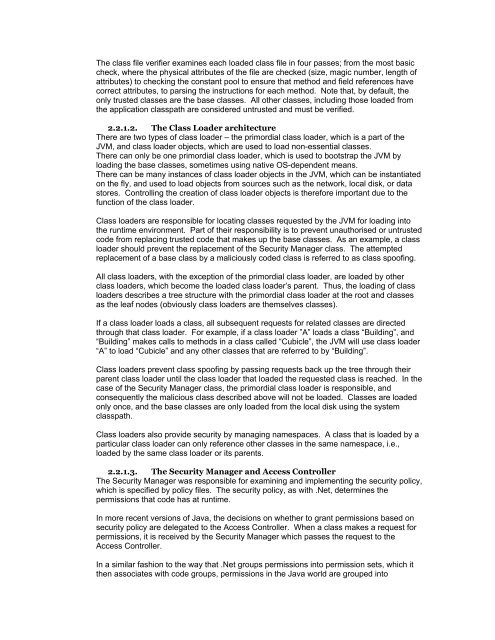J2ee and .Net security, (PDF) - CGISecurity
J2ee and .Net security, (PDF) - CGISecurity
J2ee and .Net security, (PDF) - CGISecurity
You also want an ePaper? Increase the reach of your titles
YUMPU automatically turns print PDFs into web optimized ePapers that Google loves.
The class file verifier examines each loaded class file in four passes; from the most basic<br />
check, where the physical attributes of the file are checked (size, magic number, length of<br />
attributes) to checking the constant pool to ensure that method <strong>and</strong> field references have<br />
correct attributes, to parsing the instructions for each method. Note that, by default, the<br />
only trusted classes are the base classes. All other classes, including those loaded from<br />
the application classpath are considered untrusted <strong>and</strong> must be verified.<br />
2.2.1.2. The Class Loader architecture<br />
There are two types of class loader – the primordial class loader, which is a part of the<br />
JVM, <strong>and</strong> class loader objects, which are used to load non-essential classes.<br />
There can only be one primordial class loader, which is used to bootstrap the JVM by<br />
loading the base classes, sometimes using native OS-dependent means.<br />
There can be many instances of class loader objects in the JVM, which can be instantiated<br />
on the fly, <strong>and</strong> used to load objects from sources such as the network, local disk, or data<br />
stores. Controlling the creation of class loader objects is therefore important due to the<br />
function of the class loader.<br />
Class loaders are responsible for locating classes requested by the JVM for loading into<br />
the runtime environment. Part of their responsibility is to prevent unauthorised or untrusted<br />
code from replacing trusted code that makes up the base classes. As an example, a class<br />
loader should prevent the replacement of the Security Manager class. The attempted<br />
replacement of a base class by a maliciously coded class is referred to as class spoofing.<br />
All class loaders, with the exception of the primordial class loader, are loaded by other<br />
class loaders, which become the loaded class loader’s parent. Thus, the loading of class<br />
loaders describes a tree structure with the primordial class loader at the root <strong>and</strong> classes<br />
as the leaf nodes (obviously class loaders are themselves classes).<br />
If a class loader loads a class, all subsequent requests for related classes are directed<br />
through that class loader. For example, if a class loader ”A” loads a class “Building”, <strong>and</strong><br />
“Building” makes calls to methods in a class called “Cubicle”, the JVM will use class loader<br />
“A” to load “Cubicle” <strong>and</strong> any other classes that are referred to by “Building”.<br />
Class loaders prevent class spoofing by passing requests back up the tree through their<br />
parent class loader until the class loader that loaded the requested class is reached. In the<br />
case of the Security Manager class, the primordial class loader is responsible, <strong>and</strong><br />
consequently the malicious class described above will not be loaded. Classes are loaded<br />
only once, <strong>and</strong> the base classes are only loaded from the local disk using the system<br />
classpath.<br />
Class loaders also provide <strong>security</strong> by managing namespaces. A class that is loaded by a<br />
particular class loader can only reference other classes in the same namespace, i.e.,<br />
loaded by the same class loader or its parents.<br />
2.2.1.3. The Security Manager <strong>and</strong> Access Controller<br />
The Security Manager was responsible for examining <strong>and</strong> implementing the <strong>security</strong> policy,<br />
which is specified by policy files. The <strong>security</strong> policy, as with .<strong>Net</strong>, determines the<br />
permissions that code has at runtime.<br />
In more recent versions of Java, the decisions on whether to grant permissions based on<br />
<strong>security</strong> policy are delegated to the Access Controller. When a class makes a request for<br />
permissions, it is received by the Security Manager which passes the request to the<br />
Access Controller.<br />
In a similar fashion to the way that .<strong>Net</strong> groups permissions into permission sets, which it<br />
then associates with code groups, permissions in the Java world are grouped into










